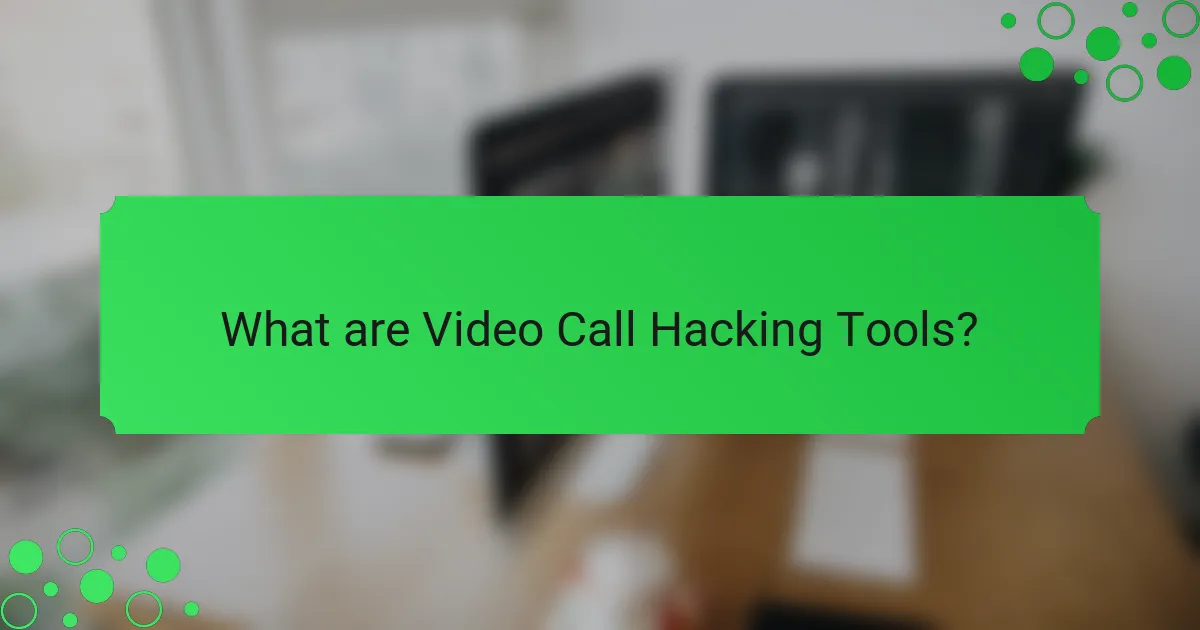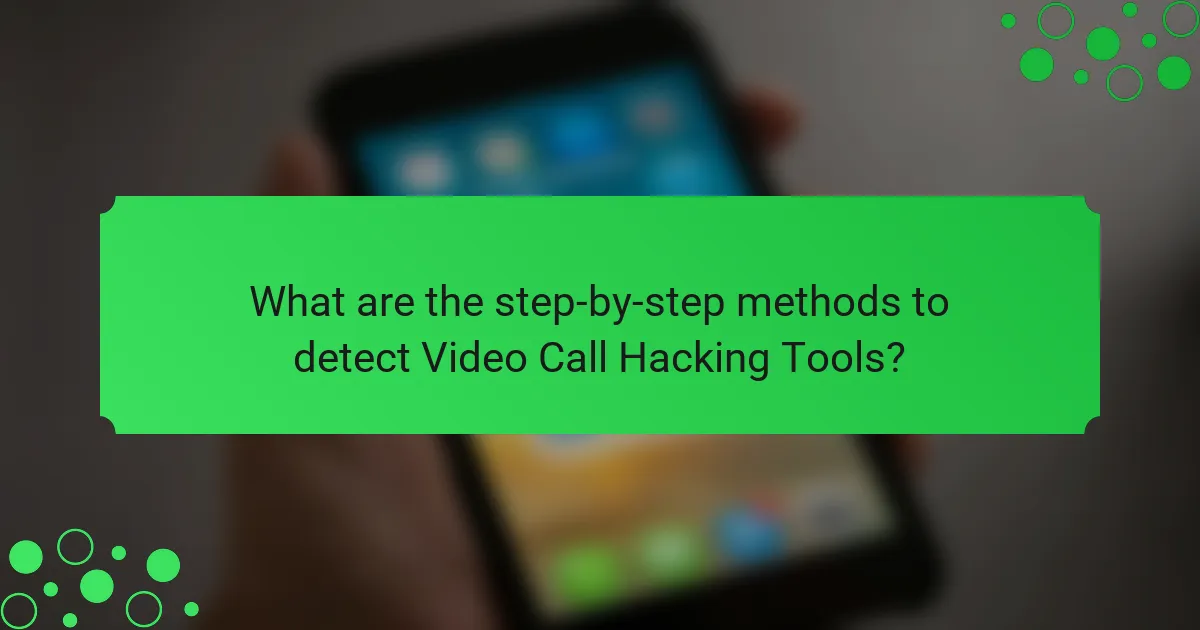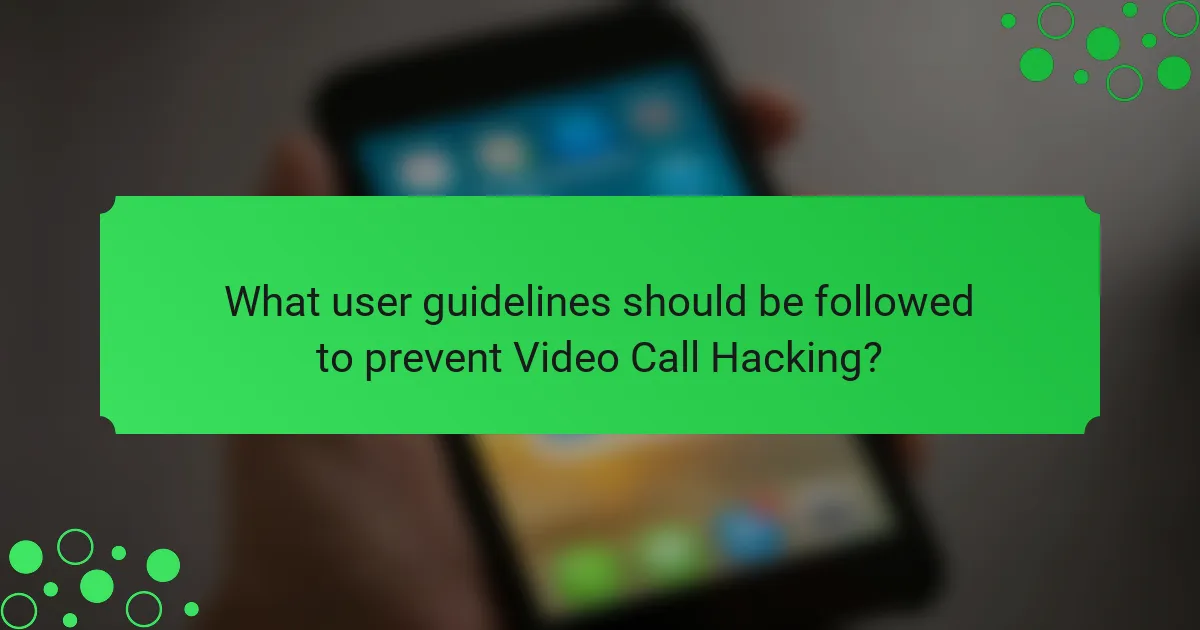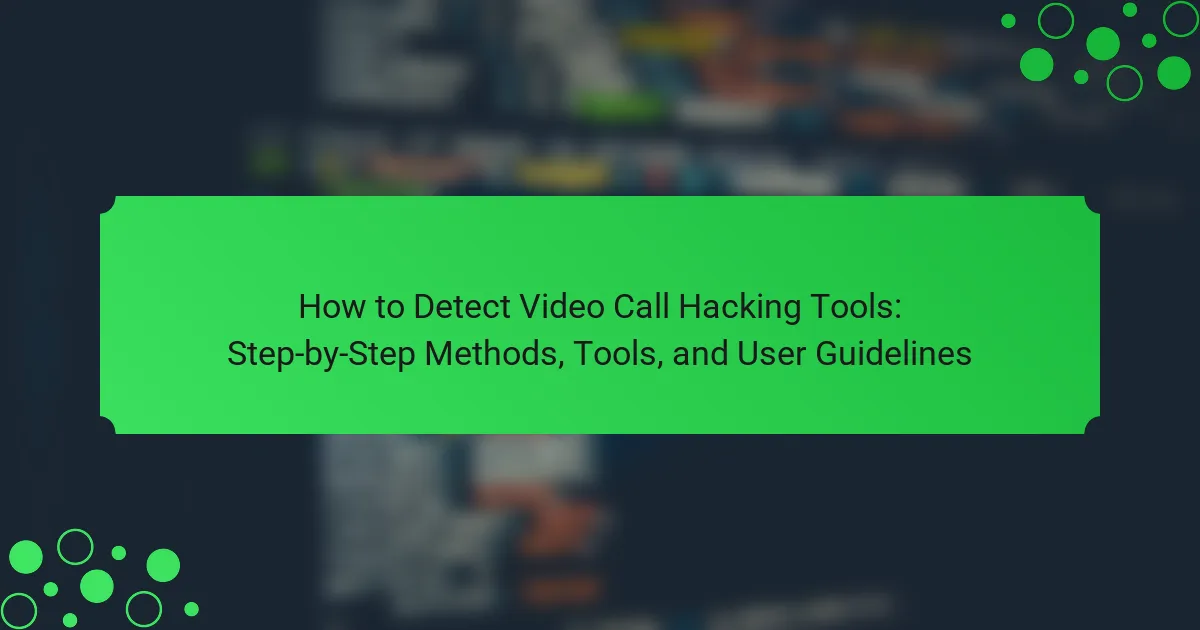Video call hacking tools are applications designed to intercept, manipulate, or disrupt video communications, posing significant risks such as eavesdropping and data theft. The article provides a comprehensive overview of methods to detect these tools, including monitoring device performance, checking for unusual software installations, and reviewing application settings. It emphasizes the importance of implementing security measures, such as using antivirus software, enabling two-factor authentication, and regularly updating video call applications. Additionally, the article highlights best practices for secure video communications, including being cautious with links shared during calls and utilizing a Virtual Private Network (VPN) for enhanced security.

What are Video Call Hacking Tools?
Video call hacking tools are software or applications designed to intercept, manipulate, or disrupt video communications. These tools can allow unauthorized access to video calls, enabling eavesdropping or data theft. They may exploit vulnerabilities in video conferencing platforms. Examples include malware that targets webcams or software designed to spoof user identities. According to cybersecurity experts, the rise in remote work has increased the prevalence of such tools. Organizations must implement security measures to protect against these threats. Awareness and detection are crucial in safeguarding video communications.
How do Video Call Hacking Tools function?
Video call hacking tools function by exploiting vulnerabilities in video conferencing software. These tools can intercept data transmitted during calls. They may use methods like phishing to gain access to user credentials. Once access is obtained, hackers can join calls undetected. Some tools may also employ malware to monitor conversations. They can manipulate video feeds or record audio without consent. Security flaws in software can be targeted to allow unauthorized access. Regular updates and security patches are essential to mitigate these risks.
What are the common types of Video Call Hacking Tools?
Common types of video call hacking tools include malware, phishing tools, and network sniffers. Malware can be installed on devices to capture audio and video feeds. Phishing tools trick users into providing login credentials for video conferencing platforms. Network sniffers intercept data packets transmitted over networks, allowing unauthorized access to video calls. These tools exploit vulnerabilities in software and user behavior. Awareness of these tools is crucial for maintaining security during video calls.
How do these tools exploit vulnerabilities in video call platforms?
These tools exploit vulnerabilities in video call platforms by leveraging security flaws in the software. Common methods include using malware to gain unauthorized access to devices. Attackers may exploit weak passwords or unpatched software vulnerabilities. They can also intercept data transmitted during calls through man-in-the-middle attacks. Phishing techniques are often employed to trick users into revealing sensitive information. Additionally, some tools can manipulate software settings to enable eavesdropping. These methods highlight the importance of robust security measures in video call applications.
Why is it important to detect Video Call Hacking Tools?
Detecting video call hacking tools is crucial for maintaining privacy and security during online communications. These tools can intercept video feeds, audio, and personal data. Unauthorized access can lead to data breaches, identity theft, and harassment. According to a report by Cybersecurity Ventures, cybercrime is projected to cost the world $10.5 trillion annually by 2025. Detecting these tools helps protect sensitive information and ensures a safe communication environment. Regular monitoring and detection can prevent unauthorized surveillance and safeguard user trust in video conferencing platforms.
What risks do Video Call Hacking Tools pose to users?
Video call hacking tools pose significant risks to users, including unauthorized access to personal data. These tools can enable hackers to intercept video and audio feeds during calls. This can lead to the exposure of sensitive information discussed during meetings. Users may also face identity theft if hackers impersonate them using captured video. Additionally, malware can be introduced to users’ devices through malicious links shared during hacked calls. A report by the Cybersecurity & Infrastructure Security Agency (CISA) highlights that video conferencing platforms are frequent targets for cyberattacks. Overall, the risks associated with video call hacking tools threaten user privacy and security.
How can detecting these tools protect personal and professional information?
Detecting video call hacking tools can protect personal and professional information by identifying unauthorized access. This detection allows users to take immediate action against potential threats. It prevents sensitive data from being captured or misused by malicious actors. For instance, tools like intrusion detection systems can alert users to anomalies during calls. According to cybersecurity research, 60% of data breaches involve video conferencing tools. Detecting these tools can significantly reduce the risk of such breaches. This proactive approach safeguards confidential conversations and proprietary information. Ultimately, detection enhances overall digital security and user confidence.

What are the step-by-step methods to detect Video Call Hacking Tools?
1. Check for unusual software installations on your device. Look for applications you did not install.
2. Monitor your device’s performance. Slow performance may indicate malicious software running in the background.
3. Review your video call application settings. Ensure that permissions granted align with your usage.
4. Look for unexpected notifications or pop-ups. These may indicate unauthorized access attempts.
5. Use antivirus software to scan for malware. Regular scans can identify and remove hidden threats.
6. Enable two-factor authentication on your video call accounts. This adds an extra layer of security.
7. Update your video call applications regularly. Updates often include security patches that protect against vulnerabilities.
8. Be cautious with links and files shared during video calls. Malicious links can compromise your device.
9. Disconnect from public Wi-Fi networks when making video calls. Public networks can be less secure.
10. Use a Virtual Private Network (VPN) for an additional layer of security. A VPN encrypts your internet traffic.
How can users identify signs of hacking during video calls?
Users can identify signs of hacking during video calls by observing unusual behaviors. Look for unexpected disconnections or poor video quality. If the audio is out of sync with the video, it may indicate tampering. Unrecognized participants joining the call is a significant red flag. Monitor for strange background noises or voices that don’t match the participants. If the call freezes or lags excessively, it could be a sign of interference. Additionally, be wary of requests to share sensitive information during the call. These indicators suggest potential hacking attempts.
What unusual behaviors should users look for in video calls?
Users should look for signs of unusual behavior during video calls to detect potential hacking. These behaviors include unexpected disconnections or interruptions. Users may also notice unusual audio feedback or echoes. Another red flag is if participants appear frozen or pixelated without network issues. Users should be wary if the camera turns on or off unexpectedly. Additionally, if screen sharing occurs without consent, it may indicate unauthorized access. Lastly, if a participant’s voice sounds altered or robotic, it could suggest manipulation. Identifying these behaviors can help users protect their privacy and security during video calls.
How can users verify the security of their video call software?
Users can verify the security of their video call software by checking for end-to-end encryption. End-to-end encryption ensures that only the communicating users can access the content of the calls. Users should also review the software’s privacy policy for data handling practices. A reputable software will clearly outline how it protects user data. Users can look for independent security audits or certifications from recognized organizations. Such audits provide assurance of the software’s security measures. Additionally, users should check for regular updates and patches from the software provider. Regular updates indicate active maintenance and vulnerability management. Lastly, users can consult user reviews and expert analyses for insights on security performance.
What tools can assist in detecting Video Call Hacking Tools?
Network monitoring tools can assist in detecting video call hacking tools. These tools analyze network traffic for unusual activity. Examples include Wireshark and SolarWinds. Wireshark captures and inspects data packets in real-time. SolarWinds provides network performance monitoring and alerts. Antivirus software can also help detect malware used for hacking. Programs like Norton and McAfee scan for known threats. Additionally, endpoint detection and response (EDR) tools can identify suspicious behavior on devices. Tools such as CrowdStrike and Carbon Black offer advanced threat detection capabilities. Regular software updates enhance security against vulnerabilities.
Which software solutions are recommended for detection?
Recommended software solutions for detection include antivirus programs, network monitoring tools, and specialized security applications. Antivirus programs like Norton and McAfee can detect malware commonly used in video call hacking. Network monitoring tools such as Wireshark help analyze traffic for unusual activity. Specialized security applications like Malwarebytes provide real-time protection against spyware and other threats. These tools are effective in identifying and mitigating risks associated with video call hacking. Their capabilities are supported by user reviews and industry analyses highlighting their effectiveness in real-world scenarios.
How do these tools enhance user security during video calls?
Video call security tools enhance user security by implementing encryption, authentication, and monitoring features. Encryption protects data transmitted during calls, ensuring that only intended participants can access the content. Authentication verifies the identity of users, preventing unauthorized access to meetings. Monitoring features can detect suspicious activities and alert users about potential threats. These measures collectively reduce the risk of hacking and unauthorized surveillance during video calls. For example, end-to-end encryption used by platforms like Zoom and Microsoft Teams secures conversations from eavesdropping.

What user guidelines should be followed to prevent Video Call Hacking?
Use strong, unique passwords for video call accounts. Enable two-factor authentication for added security. Regularly update video call software to patch vulnerabilities. Avoid sharing meeting links publicly or on social media. Use a virtual private network (VPN) for secure connections. Be cautious of unknown participants in meetings. Lock meetings once all participants have joined. Monitor for suspicious activity during calls.
How can users secure their video call environments?
Users can secure their video call environments by implementing strong passwords and enabling two-factor authentication. Strong passwords should be complex, combining letters, numbers, and symbols. Two-factor authentication adds an extra layer of security by requiring a secondary verification step. Users should also update their video conferencing software regularly to patch vulnerabilities. Using encrypted communication platforms ensures that conversations remain private. Additionally, users should be cautious about sharing meeting links publicly. Limiting screen sharing to trusted participants helps prevent unauthorized access. Finally, users can utilize virtual backgrounds to enhance privacy in their environment.
What best practices should be implemented for video call security?
Use strong passwords for video calls. Strong passwords reduce unauthorized access risks. Enable waiting rooms to control participant entry. This feature allows hosts to screen attendees before they join. Keep software updated to patch vulnerabilities. Regular updates enhance security against known threats. Use end-to-end encryption for added protection. Encryption secures data during transmission, making it unreadable to outsiders. Limit screen sharing to specific participants. This prevents unauthorized access to sensitive information. Educate participants about security protocols. Awareness reduces the likelihood of falling for phishing attacks.
How can users educate themselves about potential threats?
Users can educate themselves about potential threats by researching cybersecurity resources and staying informed about the latest threats. Online platforms like cybersecurity blogs, forums, and official government websites provide valuable information. Users should follow reputable cybersecurity organizations on social media for updates. Participating in webinars and online courses can enhance knowledge about specific threats. Reading books and articles on cybersecurity best practices is also beneficial. Regularly reviewing security news helps users stay aware of emerging threats. Engaging with local cybersecurity communities can provide additional insights and support.
What common troubleshooting steps can users take if they suspect hacking?
Users should take immediate action if they suspect hacking. First, they should change their passwords for all accounts. Use strong, unique passwords for each account. Next, enable two-factor authentication wherever possible. This adds an extra layer of security. Users should then check their account activity for unauthorized access. Look for unfamiliar devices or locations. Additionally, running a full antivirus scan is crucial. This can identify and remove malware. Users should also update their software regularly to patch vulnerabilities. Finally, consider contacting their service provider for assistance. They can provide further guidance and support.
Video call hacking tools are software designed to intercept and manipulate video communications, posing significant risks to user privacy and security. This article provides a comprehensive overview of how these tools function, the common types, and the vulnerabilities they exploit in video conferencing platforms. It emphasizes the importance of detecting these tools to protect personal and professional information and outlines step-by-step methods for users to identify signs of hacking. Additionally, recommended software solutions and best practices for securing video call environments are discussed to enhance user safety during online communications.
